|
Neither historical events nor cross-cultural currents can
explain the unique parallels in the myths and imagery of ancient
Egypt and India. Walafrid Strabo (c.
809–849) German scholar has
said: "The lotus flower, sacred to Buddha and to Osiris,
has five petals which symbolizes the four limbs and the head;
the five senses; the five digits; and like the pyramid, the four
parts of the compass and the zenith. Other esoteric meanings
abound: for myths are seldom simple, and never
irresponsible."
Indian
contacts with the Western world date back to prehistoric times.
Trade relations, preceded by the migration of peoples,
inevitably developed into cultural relations. Evidence of Indian
contact with the ancient civilizations to her west, however is
certain. Knobbed pottery vases came to Sumer from India and so
did cotton. In the Akkadian tongue, Indian cotton was expressed
by ideographs meaning "vegetable cloth." Assurbanipal
(668-626 B.C) cultivated Indian plants including the
"wool-bearing trees" of India.
According to the
Skandha Purana, Egypt (Africa) was known as Sancha-dvipa
continent mentioned in Sir Willliams Jones' dissertation on
Egypt. At Alexandria, in Egypt, Indian scholars were a common
sight: they are mentioned both by Dio Chrysostom (c. 100 A.D.)
and by Clement (c. 200 A.D.) Indirect contact between ancient
India and Egypt through Mesopotamia is generally admitted, but
evidence of a direct relationship between the two is at best
fragmentary. Peter Von Bohlen (1796-1840) German Indologist,
compared India with ancient Egypt. He thought there was a
cultural connection between the two in ancient times. There are
elements of folk art, language, and rural culture of Bengal
which have an affinity with their Egyptian counterparts and
which have not been explained satisfactorily in terms of Aryan,
Mongolian, or Dravidian influences. There are similarities
between place names in Bengal and Egypt and recently an Egyptian
scholar, El Mansouri, has pointed out that in both Egypt and
India the worship of cow, sun, snake, and river are common.
Recently, more
definitive evidence suggesting contact between India and Egypt
has become available. A terracotta mummy from Lothal vaguely
resembles an Egyptian mummy and a similar terracotta mummy is
found also at Mohenjodaro. In this context it is of interest to
note that the Egyptian mummies are said to have been wrapped in
Indian muslin. Characters
similar to those on the Indus seals have also been found on
tablets excavated from Easter Island.
Of all the
Egyptian objects and motifs indicating some contact between
India and Egypt during the Indus Valley period, "the cord
pattern occurring in a copper tablet in the Indus Valley and on
three Egyptian seals is the most striking link between the two
countries. Gordon Childe has said, "In other words, in the
third millennium B.C. India was already in a position to
contribute to the building up of the cultural tradition that
constitutes our spiritual heritage as she notoriously has done
since the time of Alexander."
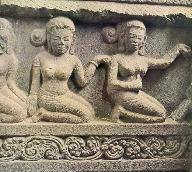



Introduction
The
Lotus and the River
Cultural Contacts with Egypt
The Sun King and Dasharatha
The Persian Connection
Links to Ancient Egypt
Conclusion
***
Introduction
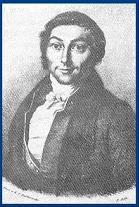 Peter
Von Bohlen
(1796-1840) German Indologist, compared India with ancient
Egypt. He thought there was a cultural connection between the
two in ancient times. Peter
Von Bohlen
(1796-1840) German Indologist, compared India with ancient
Egypt. He thought there was a cultural connection between the
two in ancient times.
(source: German
Indologists: Biographies of Scholars in Indian Studies writing
in German - By Valentine
Stache-Rosen. p.15-16).
In his book, Empire
of the Soul: Some Journeys in India, Paul
William Roberts, states:
" Recent
research and scholarship make it increasingly possible to
believe that the Vedic era was the lost civilization whose
legacy the Egyptians and the Indians inherited. There must have
been one. There are too many similarities between hieroglyphic
texts and Vedic ones, these
in turn echoed in somewhat diluted form and a confused fashion
by the authors of Babylonian texts and the Old Testament."
(source: Empire
of the Soul: Some Journeys in India - By Paul William Roberts p.
300).
It is believed
that the Dravidians from India went to Egypt and laid the
foundation of its civilization there. the Egyptians themselves
had the tradition that they originally came from the South, from
a land called Punt, which an
historian of the West, Dr. H.R. Hall,
thought referred to some part of India.
The
Indus Valley civilization is, according to Sir John Marshall who
was in charge of the excavations, the oldest of all
civilizations unearthed (c. 4000 B.C.) It is older than the
Sumerian and it is believed by many that the latter was a branch
of the former.
(source: The
Bhagvad Gita: A Scripture for the Future -
Translation and Commentary by Sachindra
K. Majumdar
p. 28).
Adolf
Erman
(1854-1937) author of Life
in ancient Egypt
and A
handbook of Egyptian religion,
says that the persons who were responsible for a highly
developed Egyptian civilization were from Punt,
an Asiatic country, a description of which is unveiled by this
scholar from the old legends - a distant country washed by the
great seas, full of valleys, incense, balsum, precious metals
and stones; rich in animals, cheetahs, panthers, dog-headed apes
and long tailed monkeys, winged creatures with strange feathers
to fly up to the boughs of wonderful trees, especially the
incense tree and the coconut trees.
Dr.
Erman further says that analyzing the Egyptian legends makes it
clear that from Punt the heavenly beings headed by Amen, Horus
and Hather, passed into the Nile valley...To this same country
belongs that idol of Bes,
the ancient figure of the deity in the Land of Punt.
M
A Murray
author of Legends
of Ancient Egypt
rightly observes that as a race the Egyptians are more Asiatic
than African. He cites the type 'P' as depicted by Hatshepsut's
artists as his support.
(source:
The
Aryan Hoax: That Dupes The Indians - By Paramesh Choudhary
p. 225).
Klaus
K. Klostermaier, in his book A
Survey of Hinduism p. 18 says:
"For
several centuries a lively commerce developed between the
ancient Mediterranean world and India, particularly the ports on
the Western coast. The most famous of these ports was Sopara,
not far from modern Bombay, which was recently renamed Mumbai. Present
day Cranganore in Kerala, identified with the ancient Muziris,
claims to have had trade contacts with Ancient Egypt under Queen
Hatsheput, who sent five ships to obtain spices, as well as with
ancient Israel during King Soloman's reign.
Apparently, the contact did not break off after Egypt was
conquered by Greece and later by Rome.
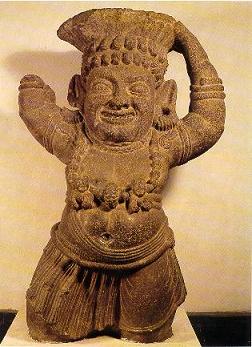
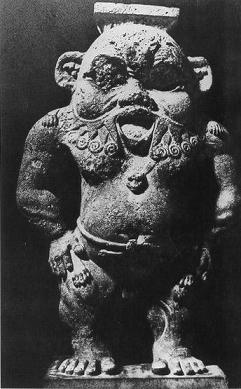 India
- Yaksha (dwarf) image discovered in cave 2nd century BC.
Egypt Bes. depicted as a deformed dwarf. 3rd century BC.
(image source: India and Egypt - edited by Saryu
Doshi p. 70 - 71).
For
more refer to chapter on Greater
India: Suvarnabhumi and
Sacred
Angkor
***
Max Muller had
also observed that the mythology of Egyptians (and also that of
the Greeks and Assyrians) is wholly founded on Vedic traditions.
Eusebius,
a Greek writer, has also recorded that the early Ethiopians
emigrated from the river Indus and first settled in the vicinity
of Egypt.
In an essay
entitled On
Egypt from the Ancient Book of the Hindus
(Asiatic Researchers Vol. III, 1792), British Lt.
Colonel Wilford
gave abundant evidence proving that ancient Indians colonized
and settled in Egypt. The British explorer John
Hanning Speke,
who in 1862 discovered the source of the Nile in Lake Victoria,
acknowledged that the Egyptians themselves didn't have the
slightest knowledge of where the Nile's source was. However, Lt.
Colonel Wilford's description of the Hindus' intimate
acquaintance with ancient Egypt led Speke to Ripon Falls, at the
edge of Lake Victoria.
Louis
Jacolliot (1837-1890), who
worked in French India as a government official and was at one
time President of the Court in Chandranagar, translated numerous
Vedic hymns, the Manusmriti,
and the Tamil work, Kural. This
French savant and author of La Bible
Dans L'Inde says:
"With such congruence before
us, no one, I imagine, will appear to contest the purely Hindu
origin of Egypt, unless to suggest that: "And who tells you
that it was not Indian that copied Egypt? Any of you require
that this affirmation shall be refuted by proofs leaving no room
for even a shadow of doubt?
"To be quite logical, then
deprive India of the Sanskrit, that language which formed all
other; but show me in India a leaf of papyrus, a columnar
inscription, a temple bas relief tending to prove Egyptian
birth."
(source: Hinduism
in the Space Age -
by E. Vedavyas p.117).
Heinrich Karl Brugsch
agrees with this view and writes in his History
of Egypt
that,
"We
have a right to more than suspect that India, eight thousand
years ago, sent a colony of emigrants who carried their arts and
high civilization into what is now known as Egypt." The
Egyptians came, according to their records, from a mysterious
land (now known to lie on the shores of the Indian Ocean)."
Col.
Henry Steel Olcott,
a former president of the Theosophical
Society,
who explained in a March, 1881 edition of The Theosophist (page
123) that:
"We have a
right to more than suspect that India, eight thousand years ago,
sent
a colony of emigrants who carried their arts and high
civilization into what is now known to us as Egypt...This is
what Bengsch Bey, the modern as well as the most trusted Egyptologer and antiquarian
says on the origin of the old Egyptians. Regarding these as a
branch of the Caucasian family having a close affinity with the
Indo-Germanic races, he insists that they 'migrated from India
before historic memory, and crossed that bridge of nations, the
Isthus of Suez, to find a new fatherland on the banks of the
Nile."
The
Egyptians came, according to their own records, from a
mysterious land...on the shore of the Indian Ocean, the sacred
Punt; the original home of their gods...who
followed thence after their people who had abandoned them to the
valley of the Nile, led by Amon, Hor and Hathor. This region was
the Egyptian 'Land of the Gods,' Pa-Nuter, in old Egyptian, or
Holyland, and now proved beyond any doubt to have been quite a
different place from the Holyland of Sinai. By the pictorial
hieroglyphic inscription found on the walls of the temple of the
Queen Haslitop at Der-el-babri, we see that this Punt can be no
other than India. For many ages the Egyptians traded with their
old homes, and the reference here made by them to the names of
the Princes of Punt and its fauna and flora, especially the
nonmenclature of various precious woods to be found but in
India, leave us scarcely room for the smallest doubt that the
old civilization of Egypt is the direct outcome of that the
older India."
(source: Theosophist
for March 1881 p. 123).
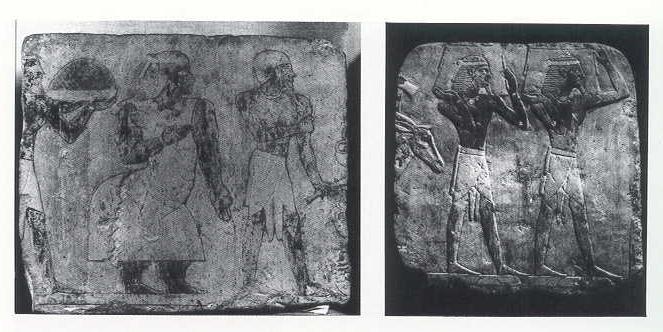
A
representation of the physical characteristics of Ita, wife of
the chief of Punt - People of Punt
carrying baskets of myrrh.
(image
source: India and Egypt - edited by Saryu Doshi
p. 32).
Watch
Lost
/ Submerged city of
Dwaraka
– The
Learning Channel video
***
Edward
Pococke (1604–1691) English Orientalist says: "At the mouths of the Indus dwell
a seafaring people, active, ingenious, and enterprising as when,
ages subsequent to this great movement.....these people coast
along the shores of Mekran, traverse the mouth of the Persian
Gulf, and again adhering to the sea-board of Oman, Hadramant,
and Yeman (the Eastern Arabia), they sail up the Red Sea; and
again ascending mighty stream that fertilizes a land of wonders,
found the kingdom of Egypt, Nubia and Abyssinia. These are the
same stock that, centuries subsequently to this colonization,
spread the blessings of civilization over Hellas and her
islands."
(source: India
in Greece - By Edward Pococke
p. 42).
Arnold
Hermann Ludwig Heeren
(1760-1842) an Egyptologist has observed:
"It is perfectly agreeable to Hindu manners that colonies
from India, i.e., Banian families should have passed over
Africa, and carried with them their industry, and perhaps also
their religious worship." "Whatever weight may be
attached to Indian tradition and the express testimony of
Eusebius confirming the report of migrations from the banks of
the Indus into Egypt, there is certainly nothing improbable in
the event itself, as a desire of gain would have formed a
sufficient inducement."
(source: Historical
Researches - Heeran p. 309).
Ethiopia, as is universally
admitted now, was colonized by the Hindus. Sir
William Jones says: "Ethiopia and Hindustan were
possessed or colonized by the same extraordinary race."
(source: Asiatic
Researches - volume I p. 426).
Louis
Jacolliot has written:
“Egypt
received from India, by Manes or Manu, its social institutions
and laws, which resulted in division of the people into four
castes, and placing the priest in the first rank; in the second,
kings; then traders and artisans; and last in the social scale,
the proletaire – the menial almost a slave.”
Manu
– Manes – Minos – Moses
A
philosopher gives political and religious institutions to India
and named Manu. The Egyptian legislator receives the name of
Manes.
A Cretan visits
Egypt to study the institutions with which he desired to endow
his country, and history preserves his memory under the name of
Minos.
Lastly, the
liberation of the servile caste of He brews founds a new society
and is named Moses.
Manu, Manes,
Minos, Moses – these four names overshadow the entire ancient
world, they appear at the cradles of four different peoples to
play the same role.
Let us beware, the times of
Brahminism, of Sacerdotalism, of Levitism, in India, in Egypt,
in Judes, presents nothing to compare with the flames of
Inquisition, the Vandois massacres, or St. Bartholomew’s
resound with Te Deum of exultation.
(source: Bible
in India: Hindoo Origin of Hebrew and Christian Revelation p
60 - 67 and 125).
Philostratus
introduces the Brahman Iarchus by stating to his auditor that
the Ethiopians were originally an Indian race compelled to leave
India for the impurity contracted by slaying a certain monarch
to whom they owed allegiance."
 Two
ancient civilizations, contemporaneous, both growing along the
banks of rivers which flow down from mountains, through desert.
Both rivers support crocodiles and both people worship river
gods and crocodiles and worship cows and have a wonderfully
developed cosmogony. Both have a form of caste system. Both have
contributed immensely to world culture in almost every field.
Surely they must have interacted despite the vast geographical
distances involved. There is evidence to suggest contact between
the two from around BCE 3000 with the findings of Indian muslin,
cotton and dhania (coriander) in Egypt. After about the third
century BCE, during the time of Ptolemy Euergetes an
Indian sailor was found shipwrecked on the coast of the Red Sea.
He was taken to Alexandria where, in exchange for hospitality,
he agreed to show the Ptolemy's men a direct sea route to India
across the Indian Ocean. Thus began a most profitable period of
contact between these two nations. During Emperor Ashoka's reign
ambassadors were exchanged. Contact continued until Egypt came
under Roman Law. After a short hiatus renewed ventures were
undertaken now bigger and powerful markets of Rome clamoring for
goods. Although trade was the reason for exchange many ideas
that influenced each other's art and iconography also passed
back and forth. There is a large body of evidence which
documents the close relationships between these two countries.
There has always been evidence to suggest indirect means of
contact between these two. Two
ancient civilizations, contemporaneous, both growing along the
banks of rivers which flow down from mountains, through desert.
Both rivers support crocodiles and both people worship river
gods and crocodiles and worship cows and have a wonderfully
developed cosmogony. Both have a form of caste system. Both have
contributed immensely to world culture in almost every field.
Surely they must have interacted despite the vast geographical
distances involved. There is evidence to suggest contact between
the two from around BCE 3000 with the findings of Indian muslin,
cotton and dhania (coriander) in Egypt. After about the third
century BCE, during the time of Ptolemy Euergetes an
Indian sailor was found shipwrecked on the coast of the Red Sea.
He was taken to Alexandria where, in exchange for hospitality,
he agreed to show the Ptolemy's men a direct sea route to India
across the Indian Ocean. Thus began a most profitable period of
contact between these two nations. During Emperor Ashoka's reign
ambassadors were exchanged. Contact continued until Egypt came
under Roman Law. After a short hiatus renewed ventures were
undertaken now bigger and powerful markets of Rome clamoring for
goods. Although trade was the reason for exchange many ideas
that influenced each other's art and iconography also passed
back and forth. There is a large body of evidence which
documents the close relationships between these two countries.
There has always been evidence to suggest indirect means of
contact between these two.
"It is testified by Herdotus,
Plato, Salon, Pythagoras, and Philostratus that the religion of
Egypt proceeded from India....It is testified by Neibuhr,
Valentia, Champollian and Weddington that the temples of upper
Egypt are of greater antiquity than those of lower Egypt...that
consequently the religion of Egypt, according to the testimony
of those monuments....came from India...The chronicles found in
the temples of Abydos and Sais and which have been transmitted
by Josephus, Julius Africanus, and Eusebius, all testify that
the religious system of the Egyptians proceeded from
India."
"We have Hindu chronologies
(besides those of the Puranas concerning the Yuga) which go
still further back in time than the Tables of the Egyptian kings
according to Manetho."
There
was intimate relations between India and Egypt. It is pointed
out that in the processions of Ptolemy Philadelphus (265-246
BCE) were to be seen Indian women, Indian hunting dogs, Indian
cows, and Indian spices.
According to the Jewish
chronicles, there was a sea voyage to the East in the
time of Soloman (c. 800
BCE). and many articles were brought from there. The use of the
Indian names for merchandise raises a strong presumption in
favor of their Indian origin. The word
'Sindhu' found in the library of Assurbanipal, is used in the
sense of Indian cotton. The Hebrew Karpas is derived from the
Sanskrit Karpassa.
One of the Jataka stories makes a
reference to a trading voyage to the kingdom of Baveru and
scholars have interpreted it as the Indian form of Babylon. This
points to trade between India and Babylon. The Boghz koi
inscriptions of the 14th century BCE. contain the names of such
deities as Mitra, Varuna, Indra etc. These names indicate that
there was a very close contact between India and Western Asia
before the 14th century BCE. There are imported Indian iron,
and steel, and Indian cotton cloth; the broad cloth called
monache and that called sagmatogene, and girdles, and coats of
skin and mallow-colored cloth, and a few muslins, and colored
lac.
 Gustav
Oppert (1836-1908)
born in Hamburg, Germany, he taught Sanskrit and comparative
linguistics at the Presidency College, Madras for 21 years. He
was the Telugu translator to the Government and Curator,
Government Oriental Manuscript Library. He wrote
a book Die Gottheiten der Indier
("The Gods of the Indians") in 1905. Gustav
Oppert (1836-1908)
born in Hamburg, Germany, he taught Sanskrit and comparative
linguistics at the Presidency College, Madras for 21 years. He
was the Telugu translator to the Government and Curator,
Government Oriental Manuscript Library. He wrote
a book Die Gottheiten der Indier
("The Gods of the Indians") in 1905.
In his
book Oppert discussed the chief gods of the Aryans and he
compares Aditi with Egyptian Isis and the Babylonian Ea.
(source: German
Indologists: Biographies of Scholars in Indian Studies writing
in German - By Valentine Stache-Rosen. p.81-82).
We
are not completely in the dark on the question of Indian
influence on Greece. Speaking of ascetic practices in the West, Professor
Sir Flinders Petrie (1853-1942) British archaeologist
and Egyptologist, author of Egypt and
Israel (1911) observes:
"The
presence of a large body of Indian troops in the Persian army in
Greece in 480 B.C. shows how far west the Indian connections
were carried; and the discovery of modeled heads of Indians
at Memphis, of about the fifth century B.C. shows
that Indians were living there for trade. Hence there is no
difficulty in regarding India as the source of the entirely new
ideal of asceticism in the West."
(source: Eastern
Religions & Western Thought - By S. Radhakrishnan
p. 150).
 He feels that
the doctrine of rebirth, favored by keeping all bodily senses in
abeyance, and brought to pass by driving out the twelve inner
torments by their antitheses, was accepted in Egypt under the
Indian influence. He feels that
the doctrine of rebirth, favored by keeping all bodily senses in
abeyance, and brought to pass by driving out the twelve inner
torments by their antitheses, was accepted in Egypt under the
Indian influence.
(source: Religious
Life in Egypt - By W. M Flinders Petrie p. 211).
Friedrich
Wilhelm, Freiherr von Bissing
(1873-1956) wrote:
"The
land of Punt in the Egyptian ethnological traditions has been
identified by the scholars with the Malabar coast of Deccan.
From this land ebony, and other rich woods, incense, balsam,
precious metals, etc. used to be imported into Egypt."
(source: Prehistoricsche
Topfen aus Indien and Aegypten - By Friedrich
Wilhelm, Freiherr von Bissing. Chapter VIII ).
The Egyptians
similarly called their ancient land Puanit (land of Panis (poenis
or traders) in Egyptian : Word corrupted to a meaningless Punt)
and before that, Amenti. Puanit can be reached leading off the
Red Sea (South-east direction) to India [specifically East
India, since Egyptians had more in common culturally with East
India , theologically similar cat headed goddess Shashti,
ancient references to embalming and afterlife in the area and
the unmistakable 'bengali' accent in Egyptian (v becomes b, a
becomes o or u (Eg Vena becomes Benu)] and Amenti should be
Indonesia. The polynesians both in Madagascar and in Fiji seem
to trace their origins to Indonesia. Indonesia is also
geographically central to almost all ancient temple-building
cultures, barring Europe
Top
of Page
The
Lotus and the River
The flower so
prolific in the imagery of both India and Egypt, grows out of
the waters and opens its petals to be warmed by the sun: to be
fertilized. From the earliest imagery in stone at Sanchi, of the
first century BC in India, the lotus is associated with Sri, the
goddess of fertility, who is later invoked as Lakshmi, the
goddess of wealth and abundance - being worshipped by Buddhists,
Jains, and Hindus alike. The lotus is held in each hand by Surya,
signifying the fertilizing powers of the sun as he travels
through the universe.
In Egypt, the blue
lotus appears in the earliest wall paintings of the VI Dynasty
at the pyramids of Saqqara and in all funerary stelae. They are
offered to the deceased, and held in the hand as thought they
possess the power to revitalize them: to bring the deceased back
to life. Carved out of blue lapis, along with the golden falcon
and the sun that are the symbols of the god Horus, the lotus
appears among the funerary treasures from the tomb of
Tutankhamen.
The lotus then,
becomes a leitmotiv, a symbol most apt since its links the
waters with the sun, the earth to sky - signifying fertility and
regeneration in both Egypt and India. For, it is the seed of the
plant which spells out the cycle of birth-decay-death and
rebirth that forms the essential pattern of belief in these two
riverine and agricultural societies. In India and Egypt, the
rivers Saraswati and Ganga and the Nile have brought sustenance
to the land and nourished these civilizations which have
survived five millennia. Both these rivers, the Ganga and the
Nile, are personified and worshipped. They provide the dramatic
backdrop against which myths and indeed created, to explain the
topographic conditions of the land.

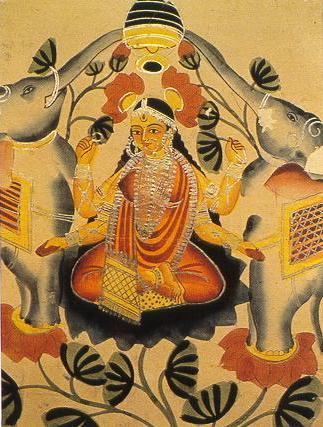
Lotus in full
bloom. Railing pillar in stupa, Sanchi Gajalakshmi seated on Lotus. Kalaghat painting
(image source: India and Egypt - edited by Saryu Doshi p. 4).
Watch
Scientific
verification of Vedic knowledge
***
From its source in
the Himalayas to the Bay of Bengal, the Ganga flows some two
thousand five hundred kilometers, through the rich deltaic
region which is known as Aryavarta, in the most densely
populated area of India. Puranic myths recount the divine
origins of Ganga, as she fell from heaven to earth in response
to penance performed by the sage Bhagiratha: to bring the powers
of water to an earth parched for over a thousand years. At the
seventh century seaport of Mahabalipuram in south India, this
epic theme is entirely carved out of a granite rock spanning
almost fifty feet. A natural cleft in the rock allows the rain
water to pour down in great torrents - as though this were the
descent of a mighty river. Besides this cleft are carved the
serpentine forms of the naga devatas (snake divinities), the sun
and the moon, the gandharvas and kinnaras (celestial beings),
the hunters and animals of the forest - all of them rejoicing in
this great event where the divine rive is celebrated as the
savior of all mankind.
Here is a
spectacular instance of the way in which myth is used to relate
man to the environment. In this myth one senses an acute
awareness of the ecological balance which needs to be
maintained: of the vapors of the sea rising to the sky through
heat, described in the myth as tapas, and then falling back to
earth as the divine river, to flow down through the matted locks
of Lord Shiva, on to the Himalayas, to flow back into the ocean.
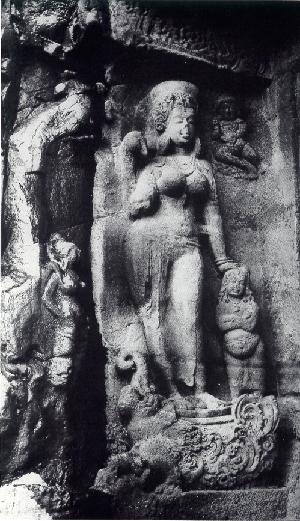
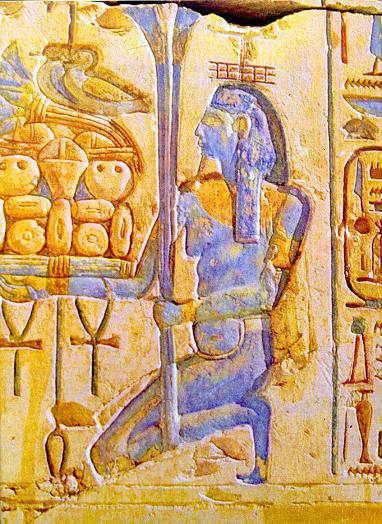
River Goddess
Ganga, Rameshvara Caves. Ellora. Hapi, god of the River Nile. Temple of Abydos, Egypt.
(image source: India and
Egypt - edited by Saryu Doshi p. 8 - 9).
***
As in India, so in
Egypt, the river is personified in human form. A sandstone
relief from the temple of Rameses II at Abydos depicts Hapi, god
of the Nile, holding a pair of blue lotus stalks in his hands;
suspended from the god's right arm is the ankh, the symbol of
life. Unlike the Ganga, the blue god of the Nile is male, but
with one female breast to symbolize his role as nourisher -
releasing the waters each year to provide sustenance to
mankind.
The main presiding
deity of the Egyptian pantheon is Osiris, like Yama, god of the
dead, whose story of life, death and regeneration has been
transmitted to us in great detail by Plutarch.
Some
extraordinary parallels with the Osirian myth are found among
the myths and images of India. Lord Vishnu lied recumbent
on the bed of the ocean asleep, as indeed Osiris lied
prostate and dead on a bier.
The Hindi word
for cow means also "ray of illumination," and in
Egyptian lore a cow is sometimes depicted as the source of light
in the sky.
***
The Puranas, Nile and Lake Amara
Significant also is the fact that Lieutenant
Speake, when planning his discovery of the
source of the Nile, secured his best information from a map
reconstructed out of Puranas. (Journal, pp.
27, 77, 216; Wilford, in Asiatic Researches, III).
It traced the course of the
river, the "Great Krishna," through Cusha-dvipa, from a great lake in
Chandristhan, "Country of the Moon," which it gave the correct
position in relation to the Zanzibar islands. The name was from the native
Unya-muezi, having the same meaning; and the map correctly mentioned another
native name, Amara, applied to the district bordering Lake Victoria Nyanza.
"All
our previous information," says Speake, "concerning the hydrography of
these regions, originated with the ancient Hindus, who told it to the
priests of the Nile; and all these busy Egyptian geographers, who disseminated
their knowledge with a view to be famous for their long-sightedness, in solving
the mystery which enshrouded the source of their holy river, were so many
hypothetical humbugs. The Hindu traders had a firm basis to stand upon through
their intercourse with the Abyssinians."
(source:
Periplus of the Erythrean Sea - W.H. Schoff p.
229-230).
The Puranas have a remarkable connection with one of the most
important discoveries of the 19th century. In 1858, John
Hanning Speke (1827-1864) – Speke was commissioned
in the British Indian Army in 1844 – made the discovery
that Lake Victoria was the source of the River Nile in Africa. Speke
wrote that to some Indian Pundits (Hindu scholars) the Nile was
known as Nila, and also as Kaali. Nila means blue and
Kaali means dark – both apt descriptions for the Nile near its
source. These are mentioned in several Puranas including the
Bhavishaya.
 This
went against the conventional wisdom, for Lake Victoria was
unknown at the time. Sir Richard Burton, the leader of the Nile
expedition, had identified Lake Tangyanika as the source. Speke,
however, following upon the advice of a Benares (Varansi)
Pundit, insisted that the real source was a much large lake that
lay to the north. Following this advice Speke went on to
discover Victoria. The Pundit had also told him that the real
source were twin peaks as Somagiri, ‘Soma’
in Sanskrit stands for moon and ‘giri’ means
peak, and Somagiri therefore are none other than the fabled Mountains
of the Moon in Central Africa! The Pundit must have
known all this. He published his book Journal
of the Discovery of the Source of the Nile in
1863. This
went against the conventional wisdom, for Lake Victoria was
unknown at the time. Sir Richard Burton, the leader of the Nile
expedition, had identified Lake Tangyanika as the source. Speke,
however, following upon the advice of a Benares (Varansi)
Pundit, insisted that the real source was a much large lake that
lay to the north. Following this advice Speke went on to
discover Victoria. The Pundit had also told him that the real
source were twin peaks as Somagiri, ‘Soma’
in Sanskrit stands for moon and ‘giri’ means
peak, and Somagiri therefore are none other than the fabled Mountains
of the Moon in Central Africa! The Pundit must have
known all this. He published his book Journal
of the Discovery of the Source of the Nile in
1863.
(source: Nostradamus
and Beyond – N S Rajaram p. 60 - 67).
Colonel
Rigby now gave me a most interesting paper, with a map attached
to it, about the Nile and the Mountains of the Moon. It was
written by Lieutenant Wilford, from the
"Purans" of
the Ancient Hindus. As it exemplifies, to a certain extent, the
supposition I formerly arrived at concerning the Mountains of
the Moon being associated with the country of the Moon, I would
fain draw the attention of the reader of my travels to the
volume of the "Asiatic Researches" in which it was
published. It is remarkable that the Hindus have christened the
source of the Nile Amara, which is the name of a country at the
north-east corner of the Victoria N'yanza. This, I think, shows
clearly, that the ancient Hindus must have had some kind of
communication with both the northern and southern ends of the
Victoria N'yanza.
(source:
Journal
of the Discovery of The Source of the Nile - http:/www.capitalnet.com/~jcbyers/Speke/nile-chap01.htm).
Top
of Page
Cultural
Contacts with Egypt
All through the ages
the peoples of India have had active intercourse with the other
peoples of the world. Since the days of Mohenjo daro culture,
the Hindus have never lived in an alleged "splendid
isolation." It is generally assumed that
internationalism or cosmopolitism is a very recent phenomenon in
human affairs. As a matter of fact, however, culture has ever
been international.
The
dawn of human civilization finds the Hindus as captains of
industry and entrepreneurs of commerce. They
were in touch with the Pharaohs of Egypt. The mummies of the
Egyptians were wrapped in muslin which was imported from
India. Hindu trade gave to the land of the Nile
ivory, gold, spices, tamarind-wood, sandal-wood, monkeys, and
other characteristic Indian plants and animals. It is also
believed that the textile craftsmen of Egypt dyed their cloth
with Hindu indigo. Hindu ships brought the Indian commodities to
the Arabian ports, or to the Land of Punt; and from there these
were transported to Luxor, Karnak and Memphis.
Hindu commerce with
the land of the Euphrates was more intimate and direct. As early
as about 3000 B.C. the Hindus supplied the Chaldean city of Ur
on the Euphrates with teak-wood. The Assyrians also, like the
Egyptians, got their muslin from India. In fact, vegetable
"wool", i.e. cotton, and wool producing plants have
been some of the earliest gifts of Hindu merchants to the world.
From the tenth to the sixth century B.C. the Assyro-Babylonian
trade of the Hindus seems to have been very brisk. Hindus
brought with them apes, elephants, cedar, teak, peacocks,
tigers, rice, ivory, and other articles to Babylon, the Rome of
Western Asia. It was through this Indo-Mesopotamian trade that
the Athenians of the sixth century B.C. came to know of rice and
peacocks.

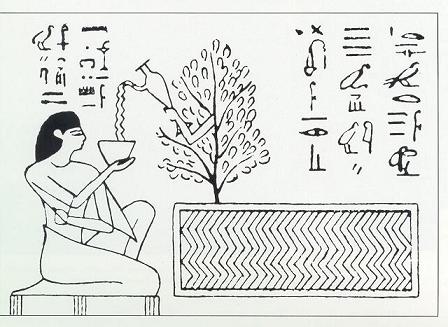
(India)
vanadevata's (wood spirit) hand issuing from tree trunk offering
water - (Egypt) deceased drinking water offered by
tree divinity
(image source: India and Egypt - edited by Saryu Doshi p. 69).
***
This expansion of
Hindu activity influenced the literature of the time, e.g. the
Vedas and Jatakas. A cylinder seal of about 2,000 B.C. bearing
cuneiform inscriptions and images of Chaldean deities have been
unearthed in Central India. In Southern India has been found a
Babylonian sarcophagus.
Hindu trade with the
Hebrews also was considerable. Soloman (1015 B.C), King of
Judaea, was a great internationalist. In order to promote the
trade of his land he set up a port at the head of the right arm
of the Red Sea. He made his race the medium of intercourse
between Phoenicians and Hindus. The port of Ophir (in Southern
India) is famous in Hebrew literature for its trade in gold
under Soloman. The Books of Genesis, Kings and Ezekiel indicate
the nature and amount of Hindu contact with Asia Minor. It is
held by Biblical scholars that the stones in the breast plate of
the high priest may have come from India. The Hindus supplied
also the demand of Syria for ivory and ebony. The
Hebrew word, tuki (peacock), is derived from Tamil (South
Indian) tokei, and ahalin (aloe) from aghil.
Top
of Page
The
Sun King and Dasharatha
Subhash Kak has observed: "A
sad consequence of the racist historiography of the 19th
century Indologists and their successors is the neglect
of India's interaction with Africa. Cyril A Hromnik's
Indo-Africa : towards a new
understanding of the history of sub-Saharan Africa
(1981) is the only book on the Indian contribution to the
history of sub-Saharan Africa that I am aware of, but it is just
an exploratory study.
The Sun King and Dasharatha - Two
historical persons with Indic connections -- one from North
Mesopotamia and the other from Egypt.
The Sun King Akhenaten of Egypt
(ruled 1352-1336 BC according to the mainstream view) was the
son-in-law to Dasharatha, the Mitanni king of North Syria,
through the queen, Kiya. (The name Dasharatha
is spelled Tushratta in the Hittite cuneiform script, which does
not distinguish between 'd' and 't' very well. Some have
suggested that the Sanskrit original is Tvesharatha, “having
splendid chariots.”) Letters exchanged between Akhenaten and
Dasharatha have been found in Amarna in Egypt and other evidence
comes from the tombs of the period that have been discovered in
excellent condition.
The Mitanni,
who worshiped Vedic gods, belonged to an Indic
kingdom that was connected by marriage across several
generations to the Egyptian 18th dynasty to which Akhenaten
belonged. The first Mitanni king was Sutarna I (“good sun”).
He was followed by Paratarna I (“great sun”), Parashukshatra
(“ruler with axe”), Saukshatra (“son of
Sukshatra, the good ruler”), Paratarna II, Artatama or
Ritadhama (“abiding in cosmic law”), Sutarna II, Dasharatha,
and finally Mativaja (Matiwazza, “whose wealth is prayer”)
during whose lifetime the Mitanni state appears to have become a
vassal to Assyria.
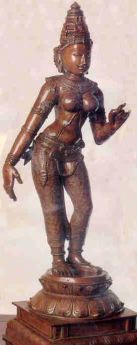 But how
could an Indic kingdom be so far from India, near Egypt? After
catastrophic earthquakes dried up the Sarasvati river around
1900 BC, many groups of Indic people started moving West.
We see Kassites, a somewhat shadowy aristocracy with Indic names
and worshiping Surya and the Maruts, in Western Iran about 1800
BC. They captured power in Babylon in 1600 BC, which they were
to rule for over 500 years. But how
could an Indic kingdom be so far from India, near Egypt? After
catastrophic earthquakes dried up the Sarasvati river around
1900 BC, many groups of Indic people started moving West.
We see Kassites, a somewhat shadowy aristocracy with Indic names
and worshiping Surya and the Maruts, in Western Iran about 1800
BC. They captured power in Babylon in 1600 BC, which they were
to rule for over 500 years.
The Mitanni ruled northern
Mesopotamia (including Syria) for about 300 years, starting 1600
BC, out of their capital of Vasukhani. (For Mitanni names, I
give standard Sanskrit spellings rather than the form that we
find in inscriptions in the inadequate cuneiform script, such as
Wassukkani for Vasukhani, “a mine of wealth.”) Their
warriors were called marya, which is the proper Sanskrit
term for it.
In a treaty between the Hittites
and the Mitanni, Indic deities Mitra,
Varuna, Indra, and Nasatya (Ashvins) are invoked. A
text by a Mitannian named Kikkuli uses words such as aika (eka,
one), tera (tri, three), panza (pancha, five), satta (sapta,
seven), na (nava, nine), vartana (vartana, round). Another text
has babru (babhru, brown), parita (palita, grey), and pinkara (pingala,
red). Their chief festival was the celebration of vishuva
(solstice) very much like in India. It is not only the kings who
had Sanskrit names; a large number of other Sanskrit names have
been unearthed in the records from the area.
The
Vedic presence via the Mitanni in Egypt and the Near East occurs
several centuries before the exodus of the Jews. This presence
is sure to have left its mark in various customs, traditions,
and beliefs. It may be that this encounter explains uncanny
similarities in mythology and ritual, such as circumambulation
around a rock or the use of a rosary of 108 beads.
(source: The
Sun King and Dasharatha
- By Subhash Kak sulekha.com).
In Indian art and
culture the existence and presence of the sphinx as a
mythological being has so far gone unnoticed and unrecognized.
But through many years of research I have found that the sphinx
plays a significant role in the arts and traditions of many
temples in India. And not only in the art, but also in ritual
and legend.
(source:
***
India's
Contact with the West
H.
R. Hall writes in his book, The Ancient
History of the Near East (London, 1913, p. 74):
“There is no doubt that the Indus must have been one of the
oldest centers of human civilization, and it seems natural to
consider that the strange non-Semitic and non-Aryan people who
came from the east to civilize the west was of Indian origin,
particularly when we see to what point the Sumerians looked like
Indians in appearance.”
The
Egyptians attributed an eastern origin
to their culture, starting that they had come from the East by
sea, from the land of “Punt”. Maritime
communications and trading from the mouths of the Indus to the
south of Arabia and as far as the Egyptians coast – very
important during the early period of Egypt – had always
existed. The fact that the Egyptians had built a canal from the
Nile to the Red Sea implies a considerable volume of trade
toward the south and east. The center of sea trade between India
and the Mediterranean appears to have been south of Arabia and
Socotra (probably the Egyptian Pas-enka), the Greek Dioscorida,
called Sukhadara dvipa (the Happy Isle) by the Indians.
 
By the
pictorial hieroglyphic inscription found on the walls of the
temple of the Queen Haslitop at Der-el-babri, we see that this
Punt can be no other than India. "It is testified by
Herdotus, Plato, Salon, Pythagoras, and Philostratus that the
religion of Egypt proceeded from India. "
The land of Punt
in the Egyptian ethnological traditions has been identified by
the scholars with the Malabar coast of Deccan. From this land
ebony, and other rich woods, incense, balsam, precious metals,
etc. used to be imported into Egypt."
(image
source: Bold Voyages and Great
Explorers: The Quest for India - By Bjorn Landstrom).
***
The
geographical sections of the Puranas (Ancient Chronicles of
India) mentions Mecca among the holy places, under the name of
Makheshvara, together with its black stone as an emblem of the
god Shiva.
The
Periplus of the Erythraean Sea, written in the first century
tells of the founding of the city of Endaemon, or modern Aden:
“In the early days of the city when the voyage was not yet
made from India to Egypt, and when they did not dare to sail
from Egypt to the ports across the ocean (those of India), but
all came together at this place, it received the cargoes from
both countries.” The Periplus indicates that Endaemon had been
founded by Indian merchants, the Minas, whom Strabo calls
Minaeans. Pliny speaks of the Minaeans as the most ancient of
trading peoples and mentions relations between the Minaeans and
King Minos of Crete. The prophet Ezekiel relates that their
trading expeditions reached as far as the Phoenician city of
Tyre.
According
to Sergi, “the Egyptians and all other Hamitic peoples came
out of Asia,” while according to Haddon, “at the beginning
of history, some Asians came to Egypt, first from the south,
eventually bringing with them bronze and probably also the
plough and wheat.”
In
the seventh century, St. Isidore made a summary in his
Encyclopedia of knowledge derived from ancient Greek and Latin
authors, many of whose works have now disappeared. He also
speaks of “Ethiopians” in his Etymologiarium (IX.2.128):
“They came in ancient times from the River Indus, established
themselves in Egypt between the Nile and the sea, towards the
south, in the equatorial regions. They became three nations: the
Hesperians to the west, the Garamantes in Tripolitania, and the
Indians in the east. (The Hesperians” are the ancient
inhabitants of Spain; “Garamantes” can be connected to
Karama “city in Dravidian); and “the Indians” refers to
the inhabitants of Ethiopia, who were also mistaken in ancient
literature for the inhabitants of India.”
Between
the 6th and the first millennium B.C.E., relations
between India and the Near East are evident. Precious stones –
amazonite – coming from Nilgiri in southern India have been
found at Ur prior to the Jemder Nasr period (3000 B.C.E). Indian
seals have been found in Bahrain and in Mesopotamia in pre-Sargonic
levels (2500 B.C.E). Traces of Indian cotton have been found,
and there are archaeological indications of sea trade with India
in the Larsa period (2170 to 1950 B.C.E). The
beams of the Temple of the Moon, at Ur of the Chaldees, and
those of the palace of Nebuchadnezzar (6th century
B.C.E.) were of teak and cedarwood coming from Malabar in
southern India.
(source:
A
Brief History of India
- By Alain Danielou p. 12 - 20).
Top
of Page
The
Persian Connection
F.
Max
Muller speaks of the colonization of Persia by the
Hindus. Discussing the word 'Arya', he says: "But it was
more faithfully preserved by the Zoroastrians, who migrated from
India to the North-west and whose religion has been preserved to
us in the Zind Avesta, though in fragments only. He again says:
"The Zoroastrians were a colony from Northern India."
(source:
Science of Language - By Max
Muller p. 242-253).
Arnold
Hermann Ludwig
Heeran says: "In point of fact that Zind
is derived from the Sanskrit, and a passage to have descended
from the Hindus of the second or warrior caste."
(source:
Historical
researches into the politics, intercourse, and trade of the
Carthaginians, Ethiopians, and Egyptians -
By A. H. Heeren Volume
II p. 220).
Sir
William Jones writes: "I was not a little
surprised to find that out of words in Du Perron's Zind
Dictionary, six or seven were pure Sanskrit."
(source:
Sir William Jones' Works
Volume I p. 82-82).
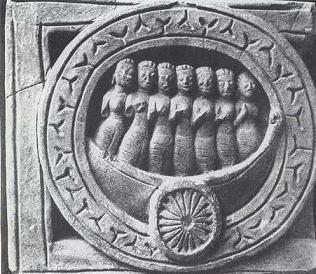

(India) A
terracotta solar plaque illustrating solar
boat (Egypt) - solar boat
(image source: India and
Egypt - edited by Saryu Doshi p. 80-81).
***
Mr
Haug, in an interesting essay on the origin of Zoroastrian
religion, compares it with Brahminism, and points out the
originally-close connection between Brahminical and the
Zoroastrian religions, customs and observances. After comparing
names of divine beings, names and legends of heroes, sacrificial
rites, religious observances, domestic rites, and cosmographical
opinions that occur both in the Vedic and Avasta writings, he
says: "In the Vedas as well as in the older portions of the
Zind-Avesta (see the Gathas), there are sufficient traces to be
discovered that the Zoroastrian religion arose out of a vital
struggle against a certain form of Brahminical religion had
assumed at a certain early period.
After
contrasting the names of the Hindu gods and the Zoroastrian
deities, he continues: "These facts throw some light upon
the age which that great religious struggle took place, the
consequence of which was the entire separation of the Ancient
Iranians from the Brahmins and the foundation of the Zoroastrian
religion. It must have occurred when Indra was the chief god of
Hinduism."
(source:
Essays on the Parsees - By
Haug p. 288).
It
is not easy to acertain when the Hindu colonization of Persia
took place. It is certain, however, that it took place before
the Mahabharata.
Col
James Tod writes: "Ujamada, by his wife, Nila,
had five sons, who spread their branches on both sides of the
Indus. Regarding three the Puranas are silent, which implies
their migration to distant regions. Is it possible that they
might be the origin of the Medes? These Medes are descendants of
Yayat, third son of the patriarch, Menu and Madai, founder of
the Medes, was of Japhet's line. Aia Mede, the patronymic of the
branch of Bajaswa, is from Aja 'a goat'. The Assyrian Mede in
Scripture is typified by the goat."
(source:
Annals
and Antiquities of Rajasthan: or the Central and Western Rajput States of India
ISBN 8120612892 Volume
I. p. 14).
Apart
from the passage in Manu, (Manusmriti is much older than
Mahabharata) describing the origin of the Ancient Persians,
there is another argument to support it. Zoroaster, the Prophet
of the Ancient Persians, was born from the emigrants from India
had settled in Persia long enough to have become a separate
nation. Vyasa held a grand religious discussion with Zoroaster
at Balkh in Turkistan, and was therefore his contemporary.
Zanthus of Lydia (B.C. 470), the earliest Greek writer, who
mentions Zoroaster, says that he lived about six hundred years
before the Trojan war (which took place about 1800 BC).
Aristotle and Eudoxus place his era as much as six thousand
years before Plato, others five thousand years before the Trojan
War, (see Pliny: Historia Naturalis, XXX, 1-3). Berosus, the
Babylonian historian, makes him a king of the Babylon between
B.C. 2200 and BC 2000. It is, however, clear that the Hindu
Colonization of Persia took place anterior to the Great War.
In
the first chapter (Fargard) of the part which bears the name
Vendidad of their sacred book (which is also their most ancient
book), Hurmuzd of God tells Zapetman (Zoroaster)" "I
have given to man an excellent and fertile country. Nobody is
able to give such a one. This land lies to the east (of Persia)
where the stars rise every evening." "when Jamshed
(the leader of the emigrating nation), came from the highland in
the east to the plain, there were neither domestic animals nor
wild nor men."
Count
Magnus Fredrik Ferdinand
Bjornstjerna (1779-1847) author
of the book, The
Theogony of the Hindoos with their systems of Philosophy and
Cosmogony says: "The country alluded to above from which
the Persians are said to have come can be no other than then the
north-west part of Ancient India - Afghanistan and Kashmir -
being to the east of Persia, as well as highland compared to the
Persian planes."
The
Chaldeans were originally migrators from India. Count
Bjornstjerna writes: "The Chaldeans, the Babylonians and
the inhabitants of Colchis derived their civilization from
India."
The
Assyrians, too were of Hindu origin. Their first king was Bali
Boal or Bel. This Boal or Bali was a great King of India in
ancient times. He ruled from Cambodia to Greece. Professor
Maurice says: "Bali...was the puissant sovereign of a
mighty empire extending over the vast continent of India."
(source:
Hindu
Raj in the World - By
Krishan Lal Jain p. 88-92).
The
code of Manu, India's great
law book, states that Dravidas, Yavanas (Greeks), Sakas (Scythians),
Pahlavas (Persians),
Kambojas (Tibetans, Siamese, Burmese), and Sinas (Chinese), are
sprung from Kshatriyas - the second highest caste who forgot
their religion and went astray.
(source:
The
Power of India - By Michael Pym p. 218).
Top
of Page
Links to
Ancient Egypt
Difficult as it is to pin point
exactly when communication between Egypt and India
commenced, it is nevertheless intriguing to note the remarkable
parallels which go as far back as the second millennium BC, if
not earlier, between the concept of the Egyptian maat and the
Vedic rita - the divine order of nature or creation, as opposed
to the chaos of falsehood. According to both the Egyptian and
Indian traditions, it was the principal duty of the king to
establish order in place of disorder or chaos. Other interesting
points of similarity between the two ancient cultures were the
deification of the forces of nature, faith in magical chants,
deep-rooted mysticism, and an emphasis on symbolic expression.
There is a close proximity
between Hindu mythology and Egyptian mythology and rituals.
"The Book of Dead" and Garuda Purana are similar. Both
are recited at the time of death. Their gods and goddesses are
also similar.
The brightest evidence of India's
direct relations with Egypt is, however, preserved in the
Mauryan Emperor Ashok's thirteenth rock edict, inscribed in the
early decades of the third century B. C. In it, Emperor
Ashoka
refers to his contacts with Ptolemy II Philadelphus of Egypt
(285-246 BC), in connection with the expansion of his policy of
the propagation of the Law of Righteousness (dharma). In the
Ashokan records of Ptolemy II is referred to as Turamaya. There
can be little doubts that official embassies were exchanged
between the Mauryan court and that of Ptolemy II. Pliny names
the Egyptian ambassador of Ptolemy II to India as Dionysius. (source:
Intercourse between India and the
Western World - By H. G. Rawlinson p. 92).

Forms of the
Djed column - Egypt Pharaonic Age

Ashokan pillar with lion capital.
India. Lotus pillar surmounted with lion heads
Egypt. Pharanoic Age.
(image source: India and Egypt - edited by Saryu Doshi
p. 66).
Watch
Scientific
verification of Vedic knowledge
*** Ashoka,
in his second rock edict, refers to the philanthropic activities
undertaken by himself. He records that he had made arrangements
for the medical treatment of men and animals in the territories
of his own empire as well as in the region ruled by Antiochus
Theos II of Syria (260-246 BC) and its neighboring kingdoms,
which also included Egypt. With
the growth of India's links with the West, there was brisk
communication in the area of trade with the Hellenistic world
including Egypt, and it is believed that Indian traders reached
the land of the Pharaohs. A Hellenistic writer, Agatharchides,
the learned tutor of Ptolemy Soter II informs one about a colony
of Indians on the island close to the mouth of the Red Sea,
named Socotra, which in Sanskrit would be Sukhottara-dvipa
(island of great joy). Socotra, must have functioned as one of
many intermediary ports between Egypt and India. Interestingly,
it is stated that the Egyptian ruler Ptolemy IV, Philopator,
lined a part of his yacht with Indian stones. The presence of
Indians in Egypt in the third century BC has been attested by
Athenaeus who observes that the processions of Ptolemy II
Philadelphus also included women, cows, and hunting dogs from
India.
(source: India
and Egypt: Influences and Interactions - edited by Saryu
Doshi).
Historians
have long known that Egypt and India traded by land and sea
during the Roman era, in part because of texts detailing the
commercial exchange of luxury goods, including fabrics, spices
and wine.
Among
their finds at the site near Egypt's border with Sudan: more
than 16 pounds (7 kilograms) of black peppercorns, the largest
stash of the prized Indian spice ever recovered from a Roman
archaeological site.
Ships
would sail between Berenike and India during the summer, when
monsoon winds were strongest, Wendrich said. From Berenike,
camel caravans probably carried the goods 240 miles (386
kilometers) west to the Nile, where they were shipped by boat to
the Mediterranean port of Alexandria, she said. From there, they
could have moved by ship through the rest of the Roman world.
Mediterranean goods, including wine from the Greek island of Kos
and fine tableware, moved in the opposite direction. This Indian
cotton textile was excavated from a Roman trash dump in the
ancient Egyptian town of Berenike. Local Ababda nomads dig in
one of the streets in Berenike, which holds an array of
artifacts that scientists say reveals an "impressive"
sea trade between the Roman Empire and India.
(source: cnn.com)
Top
of Page
India’s
cultural links with Africa since Ancient times
by Medha Vishwas Gadre
India had established contacts with Africa long before the
discovery of Monsoon winds by hippalus in 43 a.D. There are
references to the geography of Africa in Puranas. Dr.
S. Musafar Ali, notes that Salmalidwipa is the
tropical part of Africa bordering, the Indian Ocean in the West.
It included Madagascar, the Zang of Arab and Persian
geographers, the Harina of Puranas and the Sankhdwipa of some
other writers. The Hindus have accurate knowledge of many East
African localities. Col. John Speke,
the discoverer of the source of Nile, by actual discovery of
Kushadwipa has confirmed the Puranic Statement regarding the
source of Nile.
According to the Arab geographers the term Zangistan from
which the term Zanzibar or Zang Coast is derived, covers the
whole of the eastern part of the Africa, known to the Muslims. Zang
is obviously equivalent to the Sanskrit word ‘Sankh’.
The Arabs probably borrowed the name from Puranas. Sankha-Dwipa
signifies the Island of Shells.
Kakasaheb Kalelkar maintains that the very fact that the
Puranas mention Miair, the ancient Egypt, establishes that the
region must have been known to our forefathers. The ancient
Hindus knew of great sweet water Lake Victoria, which they
called Amar (Immortal) and the mountain of the Moon Rwenzore
near the source of the Nile. Nile was clearly a Sanskrit word
and secondly the Hindus were familiar with the source of the
river Nile. The region between the central lake and east of
Africa (part of Tanzania) is referred to as ‘Chandrastan’
and river Nile as Krishna in the Puranas. According
to Col. John Speke, the ancient Hindus must have had some kind
of communication with both the Northern and Southern ends of
Victoria Nyanza. An Egyptians scholar, El
Manswori, has pointed out that both in India and
Egypt, worship of cow, sun, snake and river was common. Indian
gods Shiva, Vishnu, Brahman are linked to the solar of Egypt as
the Ishwara to the Orisis, Nandi to Apis and Hanuman to
Cynocephalus. Both in India and Egypt the lotus flower too was
held sacred.
The goddess Plator was a cow, the god Neferterm, a lotus
flower, the goddess Neith was honored in the form of shield on
which two crossed arrow were nailed. Mostly, however, the
Egyptian deities were represented in animal forms. The god Khnum
was Ram. Horus a Falcon, Thoth an Ibis, Sebek a Crocodile, the
goddess Nut as Bubastis a cat and goddess Buto a Serpent. The
most famous of these sacred animals, was a sacred bull of
Memphis, Apis whom the Egyptians conceived to be the servant of
god Ptolah, Nandi, Shiva!
Brisk trade led to Indian settlement to Egypt and Egyptian
colonies in India. That contact between India and Egypt had
become closer the period is confirmed by Athenaeus, who says
that Indian women, hunting dogs, cows and spices carried on
camels, figured in the procession of Ptolemy. The saloon of
Ptolemy yacht was lined with Indian Memphis may indicate that
the existence of and Indian settlement and a ptolemic grave
stone have been excavated bearing signs of the wheel and
trident. The infant deity Horus is represented in Indian
postures seated on lotus.
The ancient kingdom of Ethiopia which evolved around the
capital Axum, developed a written language, Ge’ez providing
200 years of documentation. The Ethiopians were allowed to
control trade in gold, incense, ivory and also products imported
from Indian Ocean. The port of Adulis by the time of Periplus
had become a meeting point for the maritime trade and served as
an outlet for Axum, itself a great collecting center for ivory
from various regions. Later Cosmos confirmed that there is a
multitude of elephants with large tusks from Ethiopia. These
tusks were sent by boat to India, Persia and the Land of
Himyariteis. The Indian silk was highly prized in the region
than traditional cotton. The Roman Emperor Justinian had tried
to persuade the Ethiopians to directly purchase the silk from
India and sell it to the Romans in order to break the monopoly
of Persians, their enemy.
Lilias Homburger in his
paper says, Historical conclusions from
a study of Indo African language, the
first dynastic Egyptians came from Indus Valley, following the
same traders who had preceded them. The use of Cowrie
was brought from Maldive Islands, near the Indian Coast.
According to Mrs. Leakey, “Cowrie shells from Maldive Islands
were found in an Iron Age settlement near Nakuru in the Kenya
Highlands, establishing the possibility of very old trade
contacts between India and Africa.” According to another
authority “the Indian who traded with Egypt used Cowrie shells
for money. This system dated as far as 28th B.C.
The importance of India’s trade relations with Axumite
Empire was brought to the light by the discovery of 103 Kushana
Gold Coins around 230 A.D. contained the legends in Prakrit and
Kharoshti script as well as Greek. The Brahmi and Kharoshti
script probably had an influence on the Auximite script. Indian
merchants with Brahmi and Kharoshti alphabet were moving about,
in Ethiopia as well as Egypt from the early pre-Christian
centuries with vowel signs, affixed to the Kharoshti and Brahmi
consonants could in this way brought to the cognizance of the
Ethiopians who must have learnt their system of vowels,
indications from India, from which they were also influenced in
other respects. They recite the vowels in approximately the same
order as is customary in Sanskrit.
(source: Afro-Hindu
Vision ICCS Nagpur p 84 - 91).
Top
of Page
Masada and
Ancient India
On
the 15th of Xanthicus (roughly, April), AD 74, Eleazer
ben Yair, the son of Judah the Galilean and leader of
a Jewish community besieged by invading
Romans in
their rock fortress of Masada,
rose to address his people. He had a simple message: There would
be no surrender. They would all have to die, kill each other,
with the last man killing himself.
 Eleazer’s
listeners demurred. Sensing their fear, the charismatic leader
rose again, to deliver a final exhortation. Eleazer’s
pulsating tour de force was not about Israel, the Jewish faith
and the barbarians at the gate. Eleazer’s
listeners demurred. Sensing their fear, the charismatic leader
rose again, to deliver a final exhortation. Eleazer’s
pulsating tour de force was not about Israel, the Jewish faith
and the barbarians at the gate.
It
was, the historian Josephus was to later record, an evocation of
the Hindu rite of passage, of seeing death in the flesh as just
another milestone on the soul’s immortal journey. ‘‘Are we
not,’’ Eleazer asked, ‘‘ashamed to have lower notions
than the Indians? And by our own cowardice?’’
"We, therefore, who have
been brought up in a discipline of our own, ought to become an
example to others of our readiness to die. Yet, if we do stand
in need of foreigners to support us in this matter, let
us regard those Indians who profess the exercise of
philosophy; for these good men do but unwillingly undergo the
time of life, and look upon it as a necessary servitude, and make
haste to let their souls loose from their bodies; nay,
when no misfortune presses them to it, nor drives them upon it, these
have such a desire of a life of immortality, that they tell
other men beforehand that they are about to depart; and nobody
hinders them, but every one thinks them happy men,
and gives them letters to be carried to their familiar friends
[that are dead], so firmly and certainly do they believe that
souls converse with one another [in the other world]. So when
these men have heard all such commands that were to be given
them, they deliver their body to the fire; and, in order to
their getting their soul a separation from the body in the
greatest purity, they die in the midst of hymns of commendations
made to them; for their dearest friends conduct them to their
death more readily than do any of the rest of mankind conduct
their fellow-citizens when they are going a very long journey,
who at the same time weep on their own account, but look upon
the others as happy persons, as so soon to be made partakers of
the immortal order of beings. Are not we, therefore, ashamed to
have lower notions than the Indians? and by our own cowardice to
lay a base reproach upon the laws of our country, which are so
much desired and imitated by all mankind?"
For more refer to Wars
of the Jews
- By
Flavius Josephus
(source:
Hail
Mogambo
- By Ashok Malik - indianexpress.com and Josephus:
Wars of the Jews.,
Book VII, Chapter VIII, section vii).
Top
of Page
Conclusion
Sir
William Jones says:
"Of the
cursory observations on the Hindus, which it would require
volumes to expand and illustrate, this is the result, that they
had an immemorial affinity with the old Persians, Ethiopians and
Egyptians, the Phoenicians, Greeks, and Tuscans, the Scythians,
or Goths, and Celts, the Chinese, Japanese, and Peruvians."
(source:
Asiatic Researches - volume I p. 426).
The extensive
maritime activities of India in the remotest time led to her
earliest contacts with Egypt, Sumer, Babylon, Assyria, Judea and
many other countries. There are strong indications showing that
Egypt in remote antiquity derived her civilization from India.
Those who went from India must have mixed themselves with the
natives of the land and the indigenous culture absorbed,
rejected or modified the impulse from India. Eusebius and
Philostratus believe that Indians first colonized Abyssinia and
gradually descended to Egypt watering her civilization. The
earliest Ethiopian tradition says that they came from a land
situated near the mouth of the Indus. While there can be little
doubt that trade occupied a central position in the relations
between India and Egypt through the ages, it must be remembered
that commercial transactions brought in their wake intellectual
and cultural exchanges.
(source: The
Soul of India - By Satyavrata R. Patel ASIN
0896844536 p. 1-4).
***
Books
used for this chapter
1. India
and Egypt: Influences and Interactions - edited by Saryu
Doshi
2.
Empire
of the Soul: Some Journeys in India - By Paul William Roberts
3. Hindu
Raj in the World - By
Krishan Lal Jain
4. India
in Greece - by Edward Pococke
5. Hindu
Superiority - Har Bilas Sarda
6. The
Soul of India - By Satyavrata R. Patel
***
For
more links between India and Egypt, visit these sites:
Trade
in and metal sources for the Indian Bronze Age Civilization
http://www.hindunet.org/saraswati/trade1.htm
http://www.hindunet.org/hindu_history/sarasvati/dictionary/8095TO.HTM
India-Egypt
Connections Could Be Much More Than Anyone Can Think Of
Journal of the Discovery of the Nile - http://www.wollamshram.ca/1001/Speke/nile.htm
Top
of Page
 Did
You Know? Did
You Know?
The
Astronomical Code of the RgVeda
 The Rigveda speaks of fire altars
symbolizing the Vedic system of knowledge. The fire altars
built
of bricks in elaborate designs, are described in great detail in
the Taittirya Samhita, Satapatha Brahmana and other early texts. The Rigveda speaks of fire altars
symbolizing the Vedic system of knowledge. The fire altars
built
of bricks in elaborate designs, are described in great detail in
the Taittirya Samhita, Satapatha Brahmana and other early texts.
It is generally accepted that the
geometric constructions of the fire altars represent the
earliest Indian mathematics and geometry. There exists a
scientific basis to the Vedic fire ritual.
Astronomy is central to the
understanding of the Indian civilization, as it is to that of
other ancient civilizations. That astronomy played a very
central role in Vedic cultures is apparent from the innumerable
references to naksatras and devas (heavenly bodies) in the
earliest texts and the continuing cycle of ceremonies related to
the calendar.
The
nineteenth century Indologists were influenced by attitudes that
were inimical to the spirit of free inquiry. There were those
who wished to fit the Vedic chronology within the straitjacket
of biblical chronology and
this colored their interpretations. Most dismissed the idea of
an underlying unity because such an idea had not yet arrived in
physics, the governing metaphor being that of a mechanistic
physics. Unfortunately, these notions soon got frozen and when
science itself changed, there was no corresponding revolution in
the academic Vedic exegesis.
The Astronomical Code presents a
long forgotten code at the basis of the altars and the
organization of the Vedic books. This discovery has the greatest
implications for the understanding of ancient science and the
chronology of the ancient world. Author Subhash Kak presents an
astronomical key to unlock the secrets of the Rigveda. He shows
why the Rigveda should be prior to 2000 BC and is perhaps much
more older and how the earliest astronomy and mathematics arose
in India.
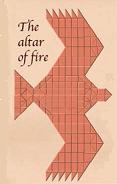 He
has discovered a long-lost astronomy of the Vedic texts which
allows us to establish a chronology of that period with
reasonable certainty. This chronology has the greatest
significance in our understanding of ancient India and its
civilization. It is generally accepted that the references to
the Vedic gods Mitra, Varuna, Indra and the Nasatyas in the
Hittite-Mitanni treaty of the second millennium B.C.E. refers to
the Indo-Aryan rather than the Iranians. It appears that the
Indic element was intrusive into South-western Asia starting
about the beginning of the second millennium. If this intrusion
was triggered by the collapse of the Harappan economy caused by
the desiccation of the Saraswati river around 1900 B.C.E. then
one can see how this intrusion was accompanied by a transmission
of the astronomy of the fire altars and the planetary period
values of the Rgveda. One might speculate that the Vedic
astronomy was taken over by the Babylonians and it was built
upon further during the flowering that took place there starting
around 700 B.C. E. He
has discovered a long-lost astronomy of the Vedic texts which
allows us to establish a chronology of that period with
reasonable certainty. This chronology has the greatest
significance in our understanding of ancient India and its
civilization. It is generally accepted that the references to
the Vedic gods Mitra, Varuna, Indra and the Nasatyas in the
Hittite-Mitanni treaty of the second millennium B.C.E. refers to
the Indo-Aryan rather than the Iranians. It appears that the
Indic element was intrusive into South-western Asia starting
about the beginning of the second millennium. If this intrusion
was triggered by the collapse of the Harappan economy caused by
the desiccation of the Saraswati river around 1900 B.C.E. then
one can see how this intrusion was accompanied by a transmission
of the astronomy of the fire altars and the planetary period
values of the Rgveda. One might speculate that the Vedic
astronomy was taken over by the Babylonians and it was built
upon further during the flowering that took place there starting
around 700 B.C. E.
The recognition of the central
role of astronomy in the Vedic world view has great significance
for the interpretation of the Vedic literature. In particular,
many Rgvedic hymns turn out to have allusions to astronomical
phenomena. Many hymns, considered paradoxical or unclear, can be
understood within an astronomical framework. The astronomical
references in the Vedic literature cannot be brushed aside any
longer. These references can be helpful in constructing a
chronology of the Vedic era.
(source: Astronomical Code of the Rig
Veda - By Subhash Kak
and Astronomy and Its Role in Vedic
Culture - By Subhash Kak in The
Dawn of Indian Civilization up to 600 BC - edited
by G. C Pande p. 615 - 620).
Watch
Scientific
verification of Vedic knowledge
(For
more refer to chapter on Greater
India: Suvarnabhumi and
Sacred
Angkor).
Top
of Page

 
 

|